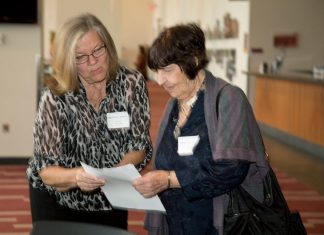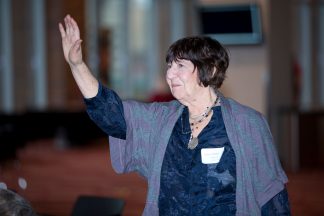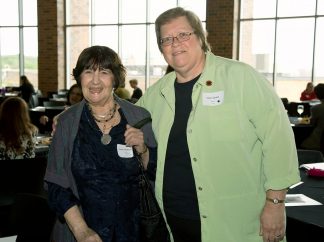By Allison Campbell-Jensen
As a scholar and an activist, Esther Wattenberg made a huge impact, in Minnesota and across the country, with her focus on improving child welfare.
As a child in Ontario, Esther Wattenberg was affected by the widespread poverty of the Great Depression. During WWII, she was distressed by news of the M.S. St. Louis, a ship of European Jews seeking refuge that was turned away by officials in Cuba, the United States, and Canada. Many of those people later died in Nazi concentration camps. As a University of Minnesota professor, she lived her values of social justice and along with others saw a need for more social workers of color. She believed so strongly in the need to increase representation within the field of social work, that she went door to door in a predominantly Black neighborhood in Minneapolis, recruiting students for the School of Social Work with full-ride scholarships.
Prior to her death in 2019, Professor Wattenberg was known for many things not the least of which included:
- profound caring;
- researching real-world issues;
- raising awareness of the plight of single mothers seeking living-wage jobs;
- convening elders and community leaders from tribal communities to train child welfare professionals ways to work with indigenous children, families, and communities;
- inviting people she knew or would like to know to the University of Minnesota to lecture;
- founding in 1992 the Center for Advanced Studies in Child Welfare (CASCW), with Jean Quam;
- supporting Democratic-Farmer-Labor Party candidates;
- inspiring federal legislation; and more
Despite her packed schedule, according to colleagues, Wattenberg always seemed available to listen.
The breadth and scope of Wattenberg’s research is too vast for this article to encapsulate. Instead, we offer a few examples of her work below — all drawn from University of Minnesota Libraries’ collections.
Wattenberg always made sure that her research was informed by practitioners and people with lived experience. She would often gather professionals, students and other key stakeholders for lunch and conversation to learn from them and to get their input on her work. One of the frequent lunch guests quotes her saying: “I have such a group of good thinkers here.”
She placed high value on the input of others. She also kept appointments with the late Walter Mondale. While he was a U. S. Senator from Minnesota, he was the sponsor of a 1973 bill to prevent child abuse. “The legislation,” LaLiberte says, “has Esther’s fingerprints all over it.”
Her boundless energy for improving the lives of those suffering in our society was one of the things that made Wattenberg remarkable. LaLiberte adds that she was tenacious and determined at a time when women were not often rewarded for those traits, “or accepted as that way — and she didn’t care.”
Improving education for social workers
Jean Quam, formerly the Dean of the College of Education and Human Development, knew Wattenberg for about 50 years. “When I came to the University [of Minnesota] to interview for a position as an assistant professor, she was the one who picked me up,” Quam remembers.
“She was a very good mentor to me,” Quam adds. “She gave me lots of advice and cared about me as a person as well as a colleague.”
Quam’s focus in social work was on older people — gerontology — yet when she became Director of the School of Social Work, circumstances forced her and Wattenberg to take a second look at the training program for child protection workers.
“It was a very tough area,” Quam says. The newly minted child protection workers would stay in their positions just a few months, then transfer to another job with the county. “They didn’t feel prepared for it; they thought it was overwhelming.”
Besides digging into data, Wattenberg started talking with the child protection workers about the challenges they were facing day to day. In response, she, Quam, and other faculty began to change the curriculum.
Wattenberg also brought in the other folks in the field who deal with children in need of help, including school social workers and police officers, and got everyone talking about better ways to work on behalf of the children and their families. In the fall and spring, she regularly organized conferences, Quam says, “on whatever the hot issue of the day was,” using grant money so that participants could attend for free.
When state legislators were considering bills that might become laws affecting children and their families, they often called Wattenberg — if she didn’t call them first. She also was a go-to source for journalists on child welfare issues, as well as writing her own opinion pieces and letters to the editor of the New York Times and other publications.
During Wattenberg’s long commitment to child welfare, Quam says, the prevailing philosophy went from doing what was in the best interest of the child to doing all that the system could to preserve the family — a tension that remains in the field and even rises to the level of the U. S. Supreme Court today in considering laws concerning Native families and their children.
Inspirational studies
 For her daughter Elizabeth Wattenberg, now a professor in the U of M School of Public Health, her mother was an inspiration.
For her daughter Elizabeth Wattenberg, now a professor in the U of M School of Public Health, her mother was an inspiration.
“She was a very, very purposeful, very thoughtful person, who always had a goal to make people’s lives better, and to really use her powerful intellect and powerful personality to try to protect the most vulnerable people, which are children.”
Along with her professional accomplishments, she was married to U of M cancer researcher Lee Wattenberg, known as the “father of chemoprevention,” and mother to six children.
The U of M’s Center for Urban and Regional Affairs (CURA) was another arena where Wattenberg made an impact. In the early 1970s, she and Sally Flax edited the three-volume CURA publication “The Study of the City: A book of readings,” which examined in-depth the complex urban settings that were inadvertently creating dire situations for poor people and people of color.
In the mid-1980s, the nation was facing impending deep budget cuts in the federal budget for social welfare services. Wattenberg researched and wrote a CURA Report titled “Down to the Bone: Community-based Facilities in a time of retrenchment.”
Among her recommendations: “Balance the competing interests of the vulnerable populations in their scramble for funds” by giving each an advocacy role — and money to run their advocacy efforts. Also: “Repair the sizable rift between the ‘practice community’ and the ‘accounting community’ by frequent consultation … and a mutual agreement on performance criteria.”
Another of her publications is from 1993: “Learning to Sing from the Same Sheet of Music: A study of family preservation integration projects for high-risk, school-age children and their families in Minnesota.”
Looking into each of these publications, as well as delving into her papers, grant applications, and correspondence held in the University Archives and the Social Welfare History Archives, Wattenberg’s conversations with families, social workers, community leaders, and officials from cities and counties were key contributions to her thinking on these profound issues.
Wattenberg’s legacy
Esther Wattenberg was an educator, an influencer of legislation, an expert on child welfare with a national reputation. We asked our sources: What legacy did she leave, as an individual and, perhaps, as a model for others?
Quam focuses on Wattenberg’s “deep commitment to making sure social workers have the tools that they need to do the best work they could do with children and their families.” She was passionate, Quam adds, that no child should be hungry or homeless or without an opportunity to have an education.
Being grounded in how the issues affected real families experiencing them was one of Wattenberg’s legacies, LaLiberte says. Her leadership resided in a conviction to check things out, “even if it slows me down.” As Wattenberg’s work progressed, LaLiberte says, her understanding grew of the nexus of poverty, underemployment, racism, and other societal ills that families have to deal with, every day.
Her daughter Elizabeth Wattenberg says: “You know, I often run into people who know her, either because they got their degree in social work or [because] my mother was very involved in DFL politics, and they know her from that. So I think she did have a very far reach in terms of what she did, and how she was able to make an impact on people both on a personal level, but also on a larger policy level.”
Three years after her death, Wattenberg is worthy of recognition both as one representative among many outstanding female scholars at the University of Minnesota for National Women’s Month, and for her years of leadership in the field of child welfare, at CURA and with CASCW. Later this month, the CASCW’s new community outreach training center will be dedicated in her name.
The strongest legacy of Esther Wattenberg? She still is listed as directing special projects on the CASCW staff page, albeit in memoriam.






